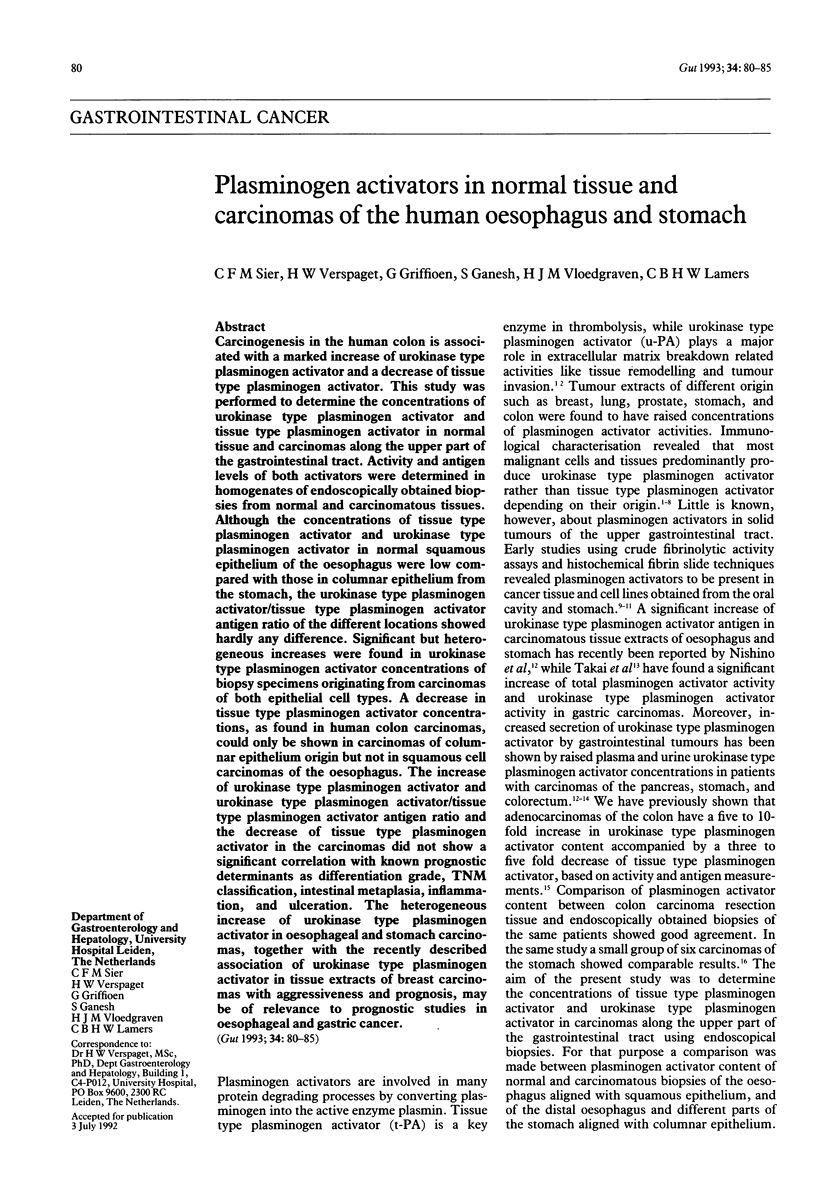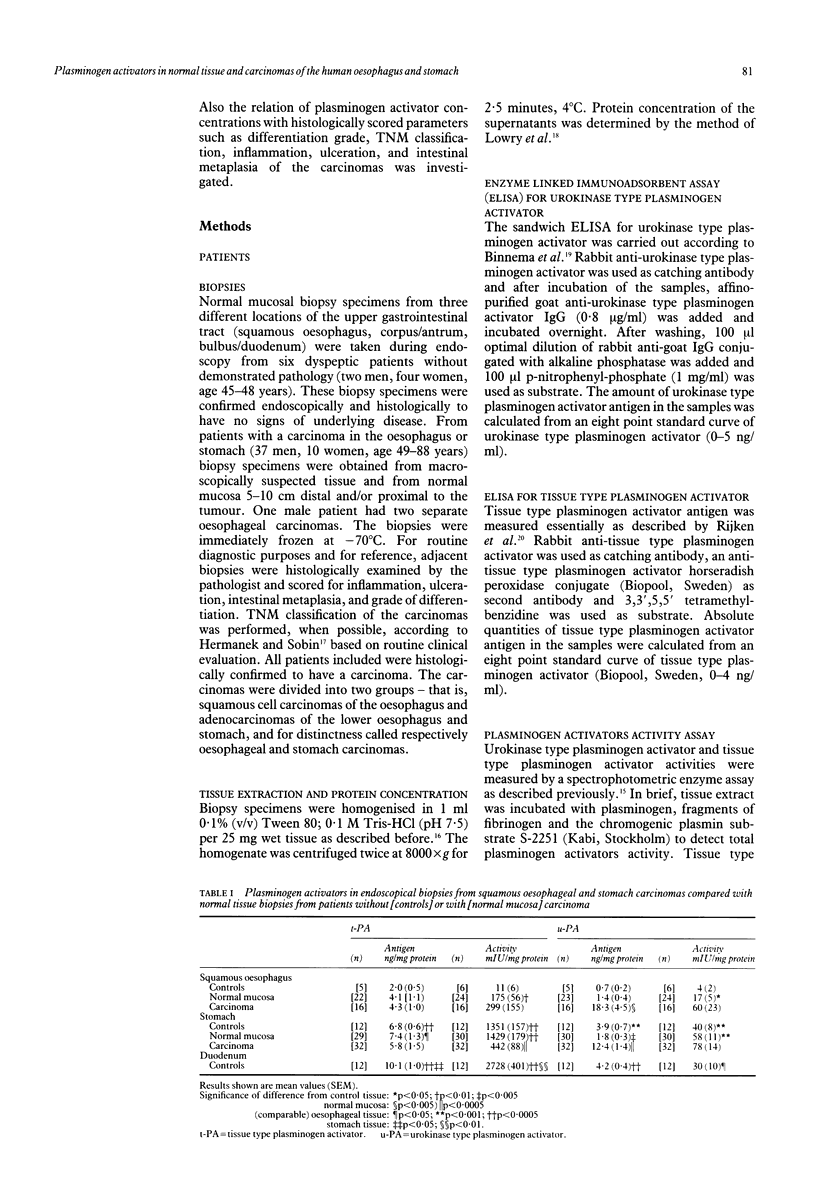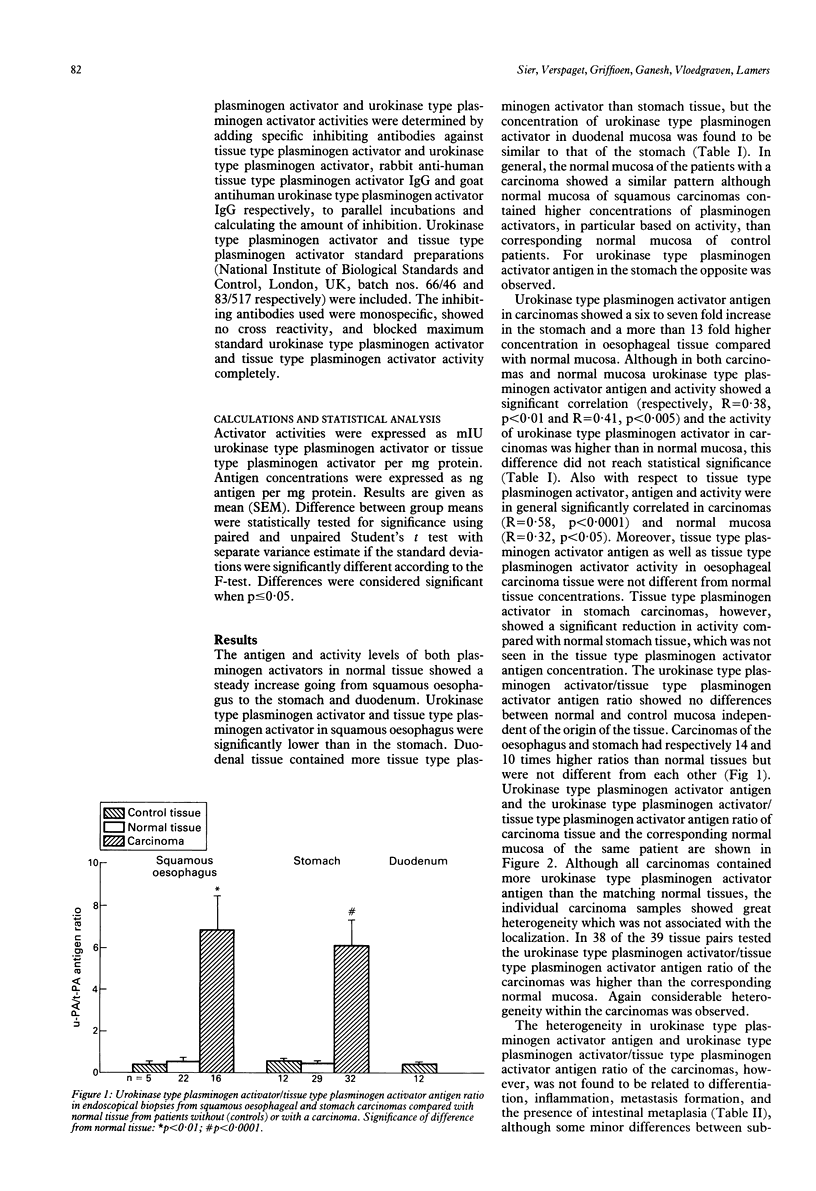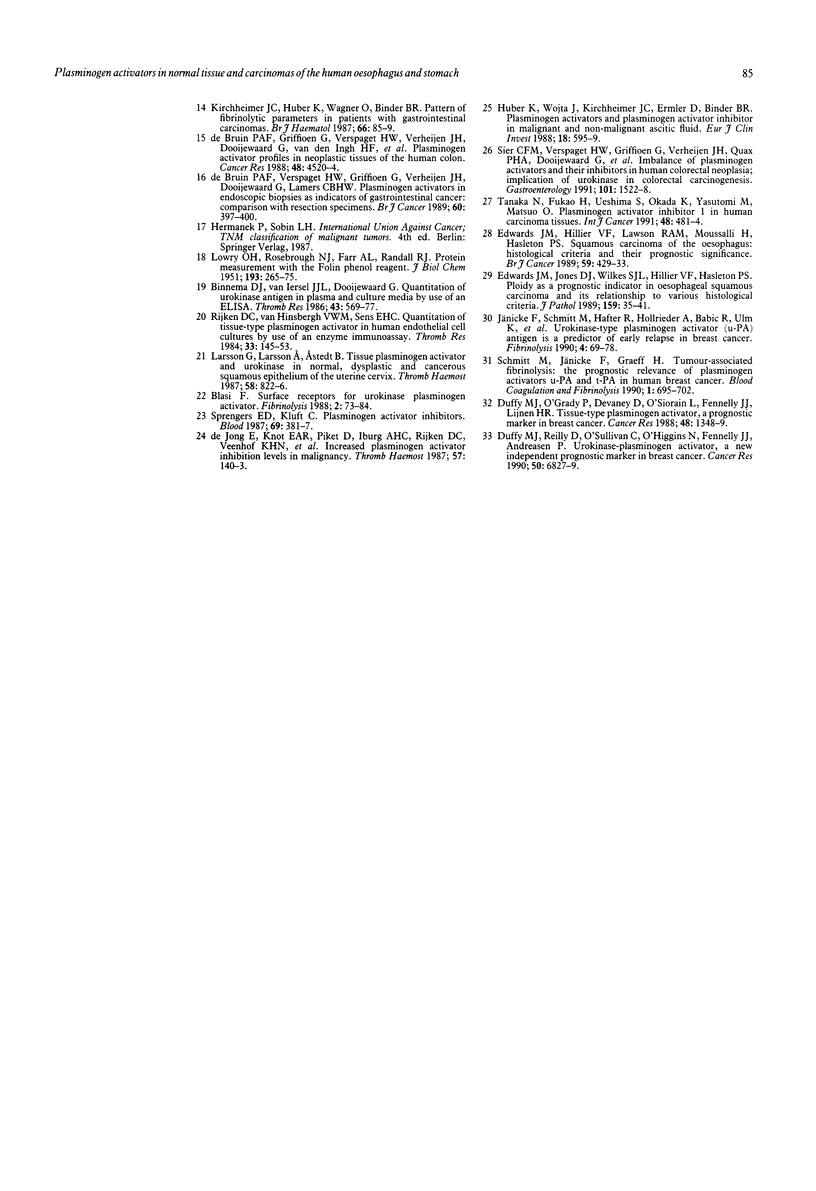Abstract
Carcinogenesis in the human colon is associated with a marked increase of urokinase type plasminogen activator and a decrease of tissue type plasminogen activator. This study was performed to determine the concentrations of urokinase type plasminogen activator and tissue type plasminogen activator in normal tissue and carcinomas along the upper part of the gastrointestinal tract. Activity and antigen levels of both activators were determined in homogenates of endoscopically obtained biopsies from normal and carcinomatous tissues. Although the concentrations of tissue type plasminogen activator and urokinase type plasminogen activator in normal squamous epithelium of the oesophagus were low compared with those in columnar epithelium from the stomach, the urokinase type plasminogen activator/tissue type plasminogen activator antigen ratio of the different locations showed hardly any difference. Significant but heterogeneous increases were found in urokinase type plasminogen activator concentrations of biopsy specimens originating from carcinomas of both epithelial cell types. A decrease in tissue type plasminogen activator concentrations, as found in human colon carcinomas, could only be shown in carcinomas of columnar epithelium origin but not in squamous cell carcinomas of the oesophagus. The increase of urokinase type plasminogen activator and urokinase type plasminogen activator/tissue type plasminogen activator antigen ratio and the decrease of tissue type plasminogen activator in the carcinomas did not show a significant correlation with known prognostic determinants as differentiation grade, TNM classification, intestinal metaplasia, inflammation, and ulceration. The heterogeneous increase of urokinase type plasminogen activator in oesophageal and stomach carcinomas, together with the recently described association of urokinase type plasminogen activator in tissue extracts of breast carcinomas with aggressiveness and prognosis, may be relevance to prognostic studies, may be of relevance to prognostic studies in oesophageal and gastric cancer.
Full text
PDF





Selected References
These references are in PubMed. This may not be the complete list of references from this article.
- Astedt B., Holmberg L. Immunological identity of urokinase and ovarian carcinoma plasminogen activator released in tissue culture. Nature. 1976 Jun 17;261(5561):595–597. doi: 10.1038/261595a0. [DOI] [PubMed] [Google Scholar]
- Baici A., Sträuli P. Release of proteinases by cultures of human cell lines derived from squamous carcinomas of the tongue and larynx. Exp Cell Biol. 1985;53(4):213–219. doi: 10.1159/000163314. [DOI] [PubMed] [Google Scholar]
- Binnema D. J., van Iersel J. J., Dooijewaard G. Quantitation of urokinase antigen in plasma and culture media by use of an ELISA. Thromb Res. 1986 Sep 1;43(5):569–577. doi: 10.1016/0049-3848(86)90077-0. [DOI] [PubMed] [Google Scholar]
- Camiolo S. M., Markus G., Evers J. L., Hobika G. H., DePasquale J. L., Beckley S., Grimaldi J. P. Plasminogen activator content of neoplastic and benign human prostate tissues; fibrin augmentation of an activator activity. Int J Cancer. 1981 Feb 15;27(2):191–198. doi: 10.1002/ijc.2910270211. [DOI] [PubMed] [Google Scholar]
- Danø K., Andreasen P. A., Grøndahl-Hansen J., Kristensen P., Nielsen L. S., Skriver L. Plasminogen activators, tissue degradation, and cancer. Adv Cancer Res. 1985;44:139–266. doi: 10.1016/s0065-230x(08)60028-7. [DOI] [PubMed] [Google Scholar]
- Duffy M. J., O'Grady P., Devaney D., O'Siorain L., Fennelly J. J., Lijnen H. R. Tissue-type plasminogen activator, a new prognostic marker in breast cancer. Cancer Res. 1988 Mar 1;48(5):1348–1349. [PubMed] [Google Scholar]
- Duffy M. J., Reilly D., O'Sullivan C., O'Higgins N., Fennelly J. J., Andreasen P. Urokinase-plasminogen activator, a new and independent prognostic marker in breast cancer. Cancer Res. 1990 Nov 1;50(21):6827–6829. [PubMed] [Google Scholar]
- Edwards J. M., Hillier V. F., Lawson R. A., Moussalli H., Hasleton P. S. Squamous carcinoma of the oesophagus: histological criteria and their prognostic significance. Br J Cancer. 1989 Mar;59(3):429–433. doi: 10.1038/bjc.1989.87. [DOI] [PMC free article] [PubMed] [Google Scholar]
- Edwards J. M., Jones D. J., Wilkes S. J., Hillier V. F., Hasleton P. S. Ploidy as a prognostic indicator in oesophageal squamous carcinoma and its relationship to various histological criteria. J Pathol. 1989 Sep;159(1):35–41. doi: 10.1002/path.1711590110. [DOI] [PubMed] [Google Scholar]
- Huber K., Wojta J., Kirchheimer J. C., Ermler D., Binder B. R. Plasminogen activators and plasminogen activator inhibitor in malignant and non-malignant ascitic fluid. Eur J Clin Invest. 1988 Dec;18(6):595–599. doi: 10.1111/j.1365-2362.1988.tb01273.x. [DOI] [PubMed] [Google Scholar]
- LOWRY O. H., ROSEBROUGH N. J., FARR A. L., RANDALL R. J. Protein measurement with the Folin phenol reagent. J Biol Chem. 1951 Nov;193(1):265–275. [PubMed] [Google Scholar]
- Larsson G., Larsson A., Astedt B. Tissue plasminogen activator and urokinase in normal, dysplastic and cancerous squamous epithelium of the uterine cervix. Thromb Haemost. 1987 Oct 28;58(3):822–826. [PubMed] [Google Scholar]
- Ljungnér H., Björlin G., Astedt B. Immunological identification of plasminogen activators in normal and malignant tissues of the oral cavity in man. Int J Oral Surg. 1984 Aug;13(4):334–338. doi: 10.1016/s0300-9785(84)80041-1. [DOI] [PubMed] [Google Scholar]
- Markus G., Takita H., Camiolo S. M., Corasanti J. G., Evers J. L., Hobika G. H. Content and characterization of plasminogen activators in human lung tumors and normal lung tissue. Cancer Res. 1980 Mar;40(3):841–848. [PubMed] [Google Scholar]
- Markus G. The relevance of plasminogen activators to neoplastic growth. A review of recent literature. Enzyme. 1988;40(2-3):158–172. doi: 10.1159/000469158. [DOI] [PubMed] [Google Scholar]
- Nishino N., Aoki K., Tokura Y., Sakaguchi S., Takada Y., Takada A. The urokinase type of plasminogen activator in cancer of digestive tracts. Thromb Res. 1988 May 15;50(4):527–535. doi: 10.1016/0049-3848(88)90201-0. [DOI] [PubMed] [Google Scholar]
- Quax P. H., van Leeuwen R. T., Verspaget H. W., Verheijen J. H. Protein and messenger RNA levels of plasminogen activators and inhibitors analyzed in 22 human tumor cell lines. Cancer Res. 1990 Mar 1;50(5):1488–1494. [PubMed] [Google Scholar]
- Rifkin D. B., Loeb J. N., Moore G., Reich E. Properties of plasminogen activators formed by neoplastic human cell cultures. J Exp Med. 1974 May 1;139(5):1317–1328. doi: 10.1084/jem.139.5.1317. [DOI] [PMC free article] [PubMed] [Google Scholar]
- Rijken D. C., van Hinsbergh V. W., Sens E. H. Quantitation of tissue-type plasminogen activator in human endothelial cell cultures by use of an enzyme immunoassay. Thromb Res. 1984 Jan 15;33(2):145–153. doi: 10.1016/0049-3848(84)90175-0. [DOI] [PubMed] [Google Scholar]
- Schmitt M., Jänicke F., Graeff H. Tumour-associated fibrinolysis: the prognostic relevance of plasminogen activators uPA and tPA in human breast cancer. Blood Coagul Fibrinolysis. 1990 Dec;1(6):695–702. [PubMed] [Google Scholar]
- Sier C. F., Verspaget H. W., Griffioen G., Verheijen J. H., Quax P. H., Dooijewaard G., De Bruin P. A., Lamers C. B. Imbalance of plasminogen activators and their inhibitors in human colorectal neoplasia. Implications of urokinase in colorectal carcinogenesis. Gastroenterology. 1991 Dec;101(6):1522–1528. doi: 10.1016/0016-5085(91)90387-z. [DOI] [PubMed] [Google Scholar]
- Sprengers E. D., Kluft C. Plasminogen activator inhibitors. Blood. 1987 Feb;69(2):381–387. [PubMed] [Google Scholar]
- Szczepański M., Lucer C., Zawadzki J., Tołoczko T. Procoagulant and fibrinolytic activities of gastric and colorectal cancer. Int J Cancer. 1982 Sep 15;30(3):329–333. doi: 10.1002/ijc.2910300312. [DOI] [PubMed] [Google Scholar]
- Tanaka N., Fukao H., Ueshima S., Okada K., Yasutomi M., Matsuo O. Plasminogen activator inhibitor 1 in human carcinoma tissues. Int J Cancer. 1991 Jun 19;48(4):481–484. doi: 10.1002/ijc.2910480402. [DOI] [PubMed] [Google Scholar]
- Tissot J. D., Hauert J., Bachmann F. Characterization of plasminogen activators from normal human breast and colon and from breast and colon carcinomas. Int J Cancer. 1984 Sep 15;34(3):295–302. doi: 10.1002/ijc.2910340302. [DOI] [PubMed] [Google Scholar]
- de Bruin P. A., Griffioen G., Verspaget H. W., Verheijen J. H., Dooijewaard G., van den Ingh H. F., Lamers C. B. Plasminogen activator profiles in neoplastic tissues of the human colon. Cancer Res. 1988 Aug 15;48(16):4520–4524. [PubMed] [Google Scholar]
- de Bruin P. A., Verspaget H. W., Griffioen G., Verheijen J. H., Dooijewaard G., Lamers C. B. Plasminogen activators in endoscopic biopsies as indicators of gastrointestinal cancer: comparison with resection specimens. Br J Cancer. 1989 Sep;60(3):397–400. doi: 10.1038/bjc.1989.293. [DOI] [PMC free article] [PubMed] [Google Scholar]
- de Jong E., Knot E. A., Piket D., Iburg A. H., Rijken D. C., Veenhof K. H., Dooijewaard G., ten Cate J. W. Increased plasminogen activator inhibition levels in malignancy. Thromb Haemost. 1987 Apr 7;57(2):140–143. [PubMed] [Google Scholar]


